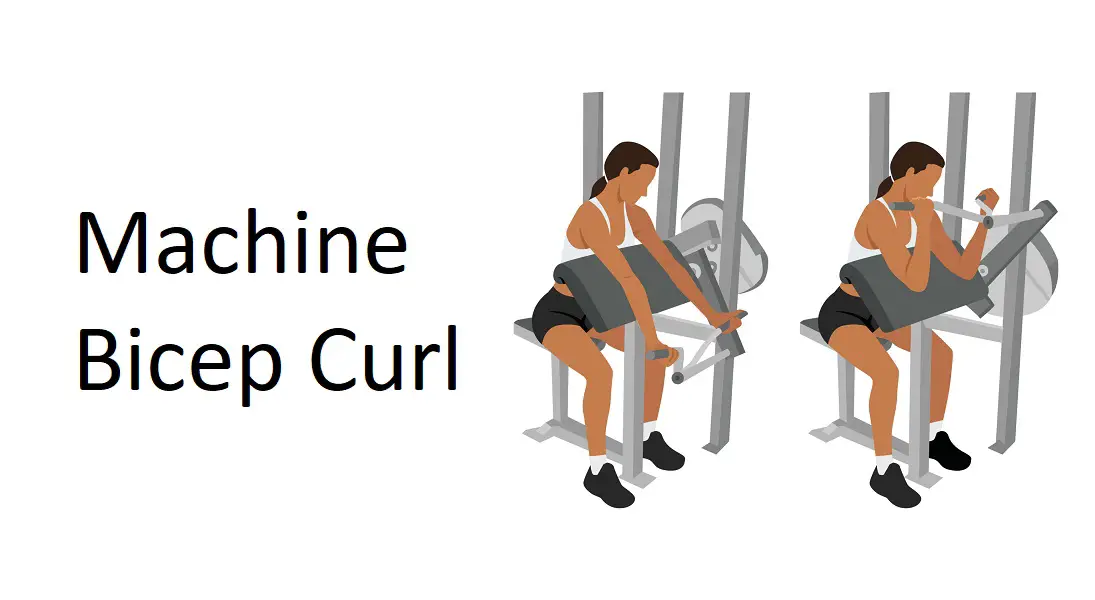The Machine Bicep Curl is a resistance exercise that targets the biceps muscles using a specialized machine equipped with adjustable weight stacks or weight plates. This exercise provides a controlled and guided movement pattern, making it ideal for beginners or those looking to isolate and strengthen their biceps muscles. In this comprehensive guide, we’ll explore the correct technique, benefits, variations, and other essential details associated with the Machine Bicep Curl.
Instructions
Setup:
- Adjust the Machine: Set the seat height and handle grips on the machine to ensure that your arms are comfortably positioned and aligned with the axis of rotation. Adjust the weight stack or weight plates to the desired resistance level.
- Position Yourself: Sit on the machine with your back flat against the pad and your feet flat on the floor. Grasp the handles with an underhand grip (palms facing up), keeping your elbows close to your sides.
Execution:
- Starting Position: Ensure that your upper arms are firmly positioned against the pads and your elbows are fully extended. Your wrists should be in a neutral position, neither flexed nor extended.
- Curling Motion: Exhale as you flex your elbows and curl the handles towards your shoulders in a smooth, controlled motion. Focus on contracting your biceps muscles while keeping your upper arms stationary throughout the movement.
- Peak Contraction: Once the handles reach shoulder level or slightly higher, pause for a brief moment to squeeze your biceps at the top of the movement. This maximizes muscle activation and helps develop muscle definition.
- Lowering Phase: Inhale as you slowly lower the handles back to the starting position, maintaining control over the descent. Avoid letting the handles slam back or using momentum to lift the weight.
- Repeat: Perform the desired number of repetitions with proper form and control, aiming for a full range of motion and maximizing muscle activation in the biceps.
Tips:
- Focus on using a smooth and controlled tempo throughout the exercise, emphasizing both the concentric (lifting) and eccentric (lowering) phases of the movement.
- Keep your back flat against the pad and avoid arching or rounding your spine during the exercise to maintain proper posture and stability.
- Avoid using momentum or swinging the handles to lift the weight. Concentrate on using your biceps muscles to perform the movement.
Benefits
- Isolation: The Machine Bicep Curl isolates the biceps muscles by stabilizing the upper arms and minimizing the involvement of other muscle groups, leading to more targeted and effective biceps training.
- Safety and Stability: The guided movement pattern of the machine provides a safe and stable environment for performing bicep curls, reducing the risk of injury and allowing for precise muscle targeting.
- Muscle Growth: By providing constant tension on the biceps muscles throughout the range of motion, the Machine Bicep Curl can help stimulate muscle growth and development over time.
- Convenience: The machine’s adjustable weight stack or weight plates make it easy to customize the resistance level to suit your strength level and training goals, allowing for progressive overload and continued muscle growth.
Muscles worked in Machine Bicep Curl
The Machine Bicep Curl primarily targets the biceps brachii muscles, which are located on the front of the upper arm. However, several other muscles are also involved in supporting and stabilizing the movement. Here are the main muscles worked during the Machine Bicep Curl:
- Biceps Brachii: As the primary mover in the exercise, the biceps brachii muscles are heavily engaged during the Machine Bicep Curl. They are responsible for flexing the elbow joint and bringing the hand towards the shoulder.
- Brachialis: The brachialis muscle lies underneath the biceps brachii and plays a significant role in elbow flexion. It is activated to a lesser extent compared to the biceps brachii but still contributes to the overall strength and size of the upper arm.
- Brachioradialis: The brachioradialis muscle is located on the forearm and assists in elbow flexion. It is activated during the Machine Bicep Curl, especially when using heavier weights or when the forearm is in a neutral position.
- Forearm Muscles: The muscles of the forearm, including the flexor muscles, are involved in maintaining grip on the handles and stabilizing the wrist joint during the curling motion. They provide support and stability throughout the exercise.
Overall, the Machine Bicep Curl is an effective exercise for targeting the muscles of the upper arm, particularly the biceps brachii, while also engaging other supporting muscles to provide stability and control. By performing the exercise with proper form and technique, you can effectively develop strength, size, and definition in the biceps.
Alternate names for Machine Bicep Curl:
- Machine Bicep Press
- Bicep Machine Lift
- Machine Arm Curl
- Bicep Machine Extension
Variations
- Single-Arm Machine Bicep Curl: Perform the exercise one arm at a time to focus on each biceps individually and address any strength imbalances between the left and right arms.
- Alternating Machine Bicep Curl: Alternate curling each arm while the other arm remains stationary. This variation allows for continuous tension on the biceps and can increase the intensity of the exercise.
- Reverse Grip Machine Bicep Curl: Perform the curling motion with an overhand grip (palms facing down) instead of an underhand grip. This variation targets the brachialis and brachioradialis muscles to a greater extent.
Conclusion
The Machine Bicep Curl is an effective exercise for targeting the biceps muscles in a safe and controlled manner. By mastering the correct technique, incorporating variations, and progressively overloading the muscles, you can achieve impressive results in biceps development and overall upper body strength.
Also, check the Incline Dumbbell Curl








